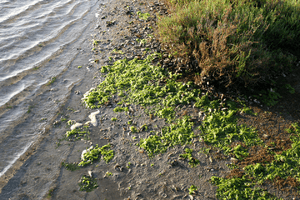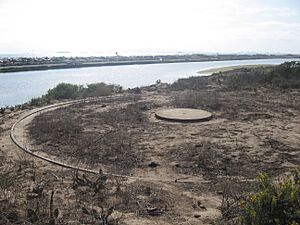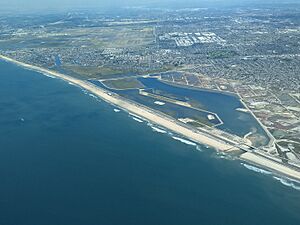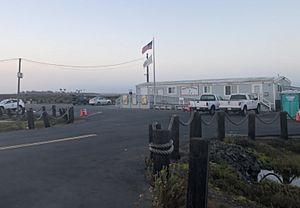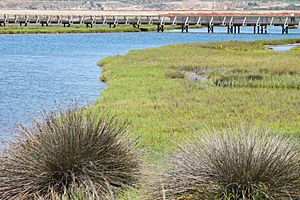Bolsa Chica Ecological Reserve facts for kids
Quick facts for kids Bolsa Chica Ecological Reserve |
|
|---|---|

Bolsa Chica Ecological Reserve and Bolsa Chica State Beach
|
|
| Location | California, United States |
| Nearest city | Huntington Beach, California |
| Area | Over 1,200 acres (4.9 km2) |
| Established | 1979 |
| Governing body | California Department of Fish and Wildlife |
The Bolsa Chica Ecological Reserve is a special natural area in Orange County, California. It is managed by the state of California. This reserve is right next to the city of Huntington Beach, California. It protects a coastal wetland and higher land. These areas are home to many threatened and endangered species of wildlife and wildflowers. Some animals live here all the time, while others just visit during their migrations.
The western edge of the reserve is next to two other state lands. These are State Highway #1, also known as Pacific Coast Highway, and Bolsa Chica State Beach. The name bolsa chica means "little bag" in Spanish. This area was once part of a large Mexican land grant called Rancho La Bolsa Chica. People also call the reserve by other names. These include Bolsa Chica Lowlands, Bolsa Chica Wetlands, and Bolsa Chica Wildlife Refuge.
Contents
History of Bolsa Chica
The Bolsa Chica area has a very long and interesting history.
Early People and Spanish Times
The first people to live here were Native American Indians. Archaeologists have found special "cog stones" that are 8,000 years old. These stones are the only things left from the Indian way of life. No one knows exactly what they were used for. Some think they were for religious ceremonies or for watching the stars. You can see cog stones at the Bowers Museum in Santa Ana.
Later, Spain took control of California. Spanish leaders created huge land areas called ranchos. One of these was Rancho Los Nietos, given to Manuel Nieto. After he died, his land was divided in 1834. One part became Rancho Las Bolsas. Then, in 1841, Rancho La Bolsa Chica was separated from Rancho Las Bolsas. Later, a man named Abel Stearns owned this land.
The Gun Club and Oil
Before 1899, the wetlands had a natural opening to the ocean. But in 1899, a group of rich businessmen formed the Bolsa Chica Gun Club. This club was for duck hunting. Famous people like Babe Ruth and Lou Gehrig visited it. The club built a big building on a hill overlooking the ocean. The Gun Club also built a dam. This dam stopped the ocean tides from flowing directly into Bolsa Chica.
In 1920, the Standard Oil Company made a deal with the Gun Club. This deal allowed them to start drilling for oil in and around the wetlands. The money from this oil was split between the Gun Club and the Bolsa Chica Land Trust.
World War II and Development Plans
In the 1940s, people worried that Japan might attack California during World War II. So, the U.S. military built two bunkers at Bolsa Chica. These were to defend the coast. Big Gun turrets were also placed on the hill. They were only fired for testing. The larger bunker was taken down in 1995. The smaller one is still there but is closed to the public. Only the round bases of the turrets remain.
In the 1960s, a company called Signal Landmark bought most of Bolsa Chica. They planned to build many houses and a marina. State officials did not like this plan. So, in 1970, the company agreed to set aside 300 acres (1.2 km2) next to Pacific Coast Highway. This land became the Bolsa Chica Ecological Reserve.
Saving the Wetlands
This action pleased state officials, but not everyone. Groups like the League of Women Voters wanted to save more of the wetlands. So, in 1976, they created a new group called Amigos de Bolsa Chica ("Friends of Bolsa Chica"). This started a 20-year fight to save the wetlands.
In 1990, the Amigos and the developer (now called Hearthside Homes) worked together. They created the Bolsa Chica Conservancy. This group's goal is to teach people why wetlands are important.
The size of the housing development plans kept getting smaller over the years. In 1992, the Bolsa Chica Land Trust was formed. These people believed that more of Bolsa Chica should be saved, not just the wetlands. The higher land (upland habitat) provides homes, shelter, and food for egrets, herons, and raptors that also use the wetlands.
In 1997, the Amigos' dream of saving the wetlands came true. The state of California bought 880 acres (3.6 km2) of the developer's land. Seven years later, a big restoration project began. It cost $147 million. In 2006, an inlet was opened to the Pacific Ocean. This was the first time the wetlands had a direct connection to the ocean since the dam was built in 1899.
In 2000, the California Coastal Commission decided that building should only happen on the upper part of the Bolsa Chica hill. They said the lower part was too important for wildlife. The developer sued, but the case was dismissed. The state later bought another 118 acres (0.48 km2) of the lower part in 2005. This allowed the developer to build houses on the upper part. Their project, with 379 homes, started in 2006.
Some 56 acres (0.23 km2) of higher land is still privately owned. Plans for building on this land are still being discussed. In 2018, the Bolsa Chica Land Trust raised $1,000,000. This money helped them buy 11.1 acres (0.045 km2) of land. This will stop houses from being built there. Instead, the land will be protected and restored.
Setting of the Reserve
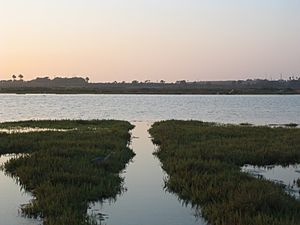
The Bolsa Chica Ecological Reserve has clear boundaries. Warner Avenue is to the north, Seapoint Avenue to the south. Pacific Coast Highway (PCH) is to the west, and houses are to the east.
There are two small parking lots for visitors. The north lot is near Warner Avenue and PCH. It has the Bolsa Chica Interpretive Center. This is where the Mesa Trail starts. This trail leads to a viewpoint at Mesa Point. The south lot is on PCH, across from Bolsa Chica State Beach. This is where the 1.5-mile (2.4 km) Loop Trail begins. This trail crosses a wooden bridge and passes two viewpoints. It then returns to the parking lot along a sand-dune path next to PCH.
The East Garden Grove Wintersburg Channel flows through the Reserve. In 2007, improvements were made to protect the wetlands from floods. Also, the Newport–Inglewood Fault, a crack in the Earth's crust, runs through the reserve.
Interpretive Center
The Bolsa Chica Conservancy Interpretive Center is open every day from 9 a.m. to 4 p.m. It has live animal exhibits and aquariums. You can find maps and information about Bolsa Chica here. They also offer education programs about wetland science.
The main room shows live marine animals that live in Bolsa Chica and off the Southern California coast. These include bat stars, ochre stars, giant-spined stars, warty sea cucumbers, Kellet’s whelks, chestnut cowries, striped shore crabs, and California spiny lobster. Another room has live reptiles. These include California kingsnakes, San Diego gopher snake, coastal rosy boa, two-striped garter snakes, and alligator lizards. The center also has many stuffed animals. You can see opossums, snakes, and birds like the great blue heron, California brown pelican, Cooper’s hawk, red-shouldered hawk, and Anna’s hummingbird.
Community Involvement
About 30,000 people visit the Reserve each year. Popular activities include Hiking, photography, and birdwatching.
There are a few special rules for the Bolsa Chica Ecological Reserve:
- Fishing is only allowed in certain areas around outer Bolsa Bay.
- Pets are not allowed in the reserve unless they stay inside a car.
Tours
Three groups offer free public tours each month at Bolsa Chica:
- The Amigos de Bolsa Chica offer tours on the first Saturday at 9 a.m. They start from the south parking lot.
- The Bolsa Chica Conservancy offers tours on the second Saturday from 10 a.m. to 12 noon. They start from the north lot.
- The Bolsa Chica Land Trust leads tours on the third Sunday at 10 a.m. They start from the south parking lot.
Amigos de Bolsa Chica
The Amigos de Bolsa Chica work to protect, restore, and care for Bolsa Chica. They focus on long-term efforts, raising awareness, and ongoing restoration. Some of their popular programs include:
- Education and Research: They offer walking tours led by guides. They also train guides and publish books about Bolsa Chica. Their FLOW Program ("Follow and Learn about the Ocean and Wetland") helps people learn about coastal nature. Community members meet every Friday to collect and test water samples. This data helps monitor the environment.
- Sustainable Restoration and Stewardship: For over 40 years, the Amigos have worked to keep the reserve healthy. Community members can train to become guides or citizen scientists. They can also join monthly wetland clean-ups, teach water quality classes, and help with the Board of Directors.
Bolsa Chica Conservancy
The Bolsa Chica Conservancy has many after-school and volunteer programs. These programs encourage people to get involved in protecting nature. The Conservancy focuses on research and restoration:
- Research: They regularly test water quality. Volunteers also help by counting birds to gather data on local bird populations. The Eyes on Nest Sites (EONS) project started in 2010. It focuses on endangered California least terns and threatened western snowy plovers.
- Restoration: Cleaning up trash and restoring the environment are important volunteer tasks. Public Service Day is held on the last Saturday and second Sunday of every month. It usually involves removing trash, planting native plants, and taking out plants that don't belong. All these efforts help keep these rare coastal wetlands healthy.
Bolsa Chica Land Trust
The Bolsa Chica Land Trust offers education and volunteer programs. These programs encourage hands-on involvement with the Bolsa Chica Ecological Reserve. Some of their main community programs are:
- Stewards Restoration Project: The Stewards and Junior Stewards Programs work with the California Department of Fish and Wildlife. They aim to fully restore the natural habitat of the Bolsa Chica Ecological Reserve. They meet twice a month to plant native species, remove non-native species, and pick up trash.
- Miracles of the Marsh: This is an education program for elementary school students. It offers students a walking tour of Bolsa Chica led by a guide. The program also includes a field guide for teachers and a presentation before the visit.
Wildlife at Bolsa Chica

Many different animals live in the Reserve. In the water, you can find shovelnose guitarfish, grey smooth-hound sharks, California halibut, and white seabass. In the grassy areas, there are snakes. These include harmless kingsnakes and gopher snakes. You might also see rattlesnakes, like western diamondbacks and Pacific rattlesnakes. Other animals include western fence lizards, cottontail rabbits, Beechey ground squirrels, and coyotes.
In spring and fall, many migratory birds visit the Reserve. Over the last ten years, 321 different bird species have been seen here. Orange County has about 420 bird species in total! Some birds at the reserve include the endangered light-footed rail, snowy plover, Savannah sparrow, least tern, Caspian tern, great blue heron, snowy egret, double-crested cormorant, red-tailed hawk, great horned owl, and California gnatcatcher.
